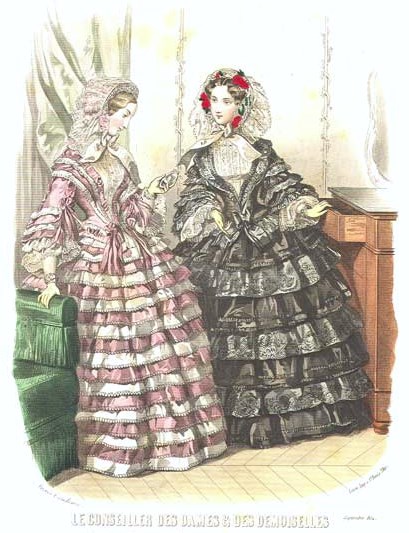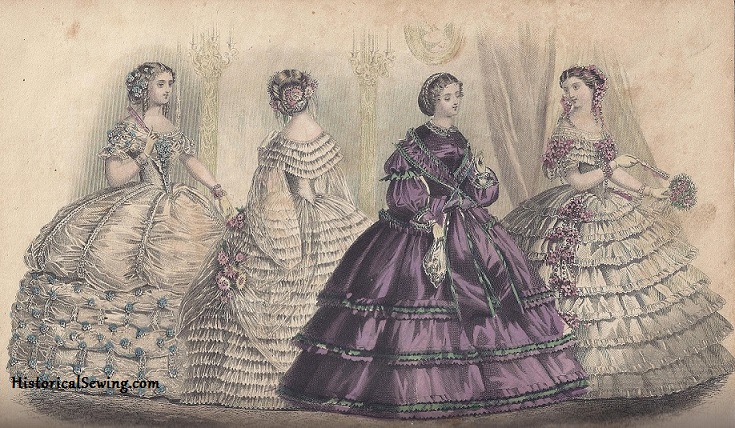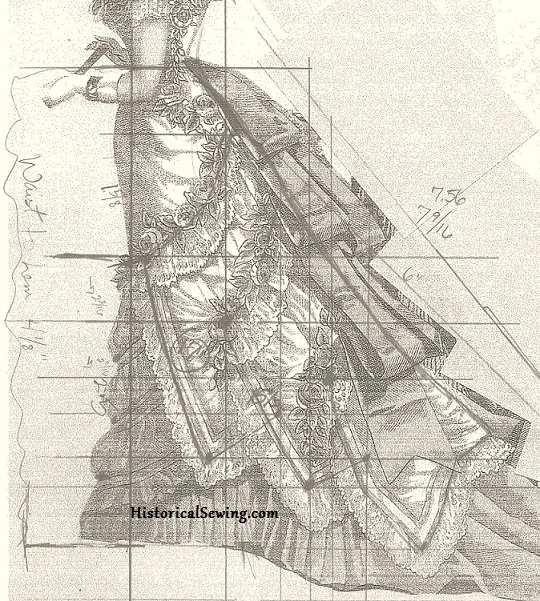
Have you ever made up a pattern with skirt ruffles, and then when you saw it on yourself it was, like, “Holy Smokes! I’m drowning in those ruffles! They are way too large for my short height.”
Or perhaps you are quite tall and skirts seem never-ending in their length. Then you carefully mount a few rows of ruffles but they seem so puny, as if they were a last thought.
I completely understand this frustration. BUT… with a little math (it’s not that hard, I promise) you can calculate those ruffles before you even cut the fabric resulting in proportions that fit you perfectly!

#1 – Get a sketch of your historical design
The first thing you need is your design drawn out. It can be a fashion plate to reproduce, a picture of an antique garment, a painting, or your sketch of what you want to make. Draw in the ruffles as you want them on the skirt.
Are you making a completely ruffled Civil War ball gown with about 17 rows of ruffles all around? (Leave time for gathering if you do!!) Or do you simply want a couple of small ruffles along the hem of a 1870s skirt? Explore various ideas of the era you are working in to narrow down how many ruffles you want on your skirt.
If you are making a reproduction from a design in a book I highly suggest you make a photocopy of that page so as to not write all your math work in the book. Save the drool books!
If you are reproducing an antique garment in your possession, well, you can easily obtain the precise measurements to reproduce the ruffles. Although, if your skirt length varies greater than 2″ in either direction from the antique skirt, use the method here for any adjustments you need to make for cutting the ruffles for your height.

#2 – Measure your design as seen on paper
First, draw a horizontal line along the design’s waistline. Then draw in a straight line down from its waistline to the hem of the skirt. Measure the vertical line with a ruler. It will be a few inches.
Next, draw in horizontal lines where the TOP of each ruffle row is attached. You might have some guess work here as most ruffles are sewn so that the one above is hiding the top of the one below.
Now measure from the design waistline down to each of those ruffle lines and pencil in the measurements.
This is tiny measuring here! You may have the waist to hem of only 3″ and the waist to the top of the first ruffle only 3/8″. If you find inch measurements are too big (like, 1/8″ is simply too wide for your sketch) mark everything in 1/16″ figures or use millimeters/centimeters.
#3 – Take your measurements
You can do this straight to a list on paper or even take a picture of yourself and write in the measurements that correspond to your figure.
Measurements to take over any/all appropriate silhouette undergarments (corset, bustle, hoop, pads, multiple petticoats, etc.):
Waist to floor/hem level at center front
Waist to floor/hem level at center back
Waist to knee level (to give you a rough idea of where the design will translate on you; use for more fine tuning)
Waist to any other part of your lower body that corresponds to your design (same purpose as above); if you want a ruffle to start around mid-thigh level, measure from your waist down to there. If your design has two small ruffles at the hem, measure from your waist down to approximately where you want the top ruffle to start.
#4 – Play with Proportions
Here is where we get to basic math – do not panic….
Ratio calculation is defined as: A is to B as Y is to X and you solve for X. Your task, should you dare go on, is to figure out what measurement is represented by the letters.
Whereas…
A = design length measurement waist to hem
B = your waist length measurement to skirt hem
Y = design waist length measurement down to the top of (any) ruffle
X= your length measurement from waist down to (any) ruffle
Example: A three-tiered 1850s ruffled skirt. Design skirt is 3″ on paper (A); your skirt length is 42″ over hoop & petticoats (B). Design shows the top tier at 9/16″ down from the waist (Y). Solve for X.
A = 3″ Y = 9/16″ (.5625)
X
B = 42″ X = ??
Now you multiply diagonally: 3 x X = 42 x 9/16 which comes to: 3X = 23.625. Then you divide by 3 so X remains by itself. 23.625 / 3 = 7.875.
This means that your top ruffle will start 7 7/8″ down from your waistline.
The second ruffle tier is 1 3/8″ (1.375) down from the design waistline. Start your calculation again keeping both your and the design waist to skirt hem as your baseline.
A = 3″ Y = 1 3/8″ (1.375)
X
B = 42″ X = ??
Multiply diagonally: 3X = 57.75. Then divide by 3 which comes to: 57.75 / 3 = 19.25. So your second ruffle will be attached 19 1/4″ down from your waistline.
To finish the third, bottom ruffle, the design measures 2 1/16″ (2.0625).
A = 3″ Y = 2 1/16″ (2.0625)
X
B = 42″ X = ??
Multiply diagonally: 3X = 86.625. Divide by 3 which comes to: 86.625 / 3 = 28.875. So the third ruffle will be attached 28 7/8″ down from your waistline.
For your reference, this also means the bottom ruffle is sewn on at 13 1/8″ up from the hem (as your finished hem length is 42″ and subtracting the sew line of 28 7/8″ leaves you with 13 1/8″ left of your skirt.

This ratio calculation can be used for any design and people measurements. If you are rather tall with a 46″ skirt length, then you simply enter that number into the calculation. If your skirt length only measures 36″ (like Queen Victoria) then you use that number and the rest calculates out the same.
This method gives you correct proportional measurements as they pertain to your figure height in regards to your design. You can see the importance here of having a design to work from. If you go “off the cuff” as you construct your costume that’s how the proportions get wonky and look off in the end.
The key is to carefully draw in the main horizontal and vertical lines that match to design features, and also to know your corseted waistline to desired garment length.
Now that you know what depth you need for your ruffles, explore this article on how to calculate the yardage you need for all those pretty layers.
Let the fun begin! Using ratios, you can apply this basic math technique whenever you are attempting to re-create a fashion plate or museum garment but get it scaled specifically for your height. Use it for sleeve lengths, trims, bodice lengths – anything at all!
(Oooohhhh! Did your world just open to the possibilities? Wonderful!)
Have you used ratio calculations before when making period clothing? Did you find it frustrating or amazingly helpful?

I prefer just altering the original image on the computer until it is proportional to my measurements. I work in metric so a 1:10 ratio usually works if my skirt length is 110cm I change the image size until it’s 11cm tall on my computer monitor and place a clear ruler over the top to measure the design.
Genius! Thank you so much for figuring this all out for us! Being numerically dyslexic and under 5′ tall, keeping things in proportion has always been a serious headache for me. But even I understand those simple formulas! Wonky proportions are now to be a thing of the past.
Holy cow! Thank so much for that – math and I are not friends so having my own equation for figuring those things out is going to be a lifesaver!